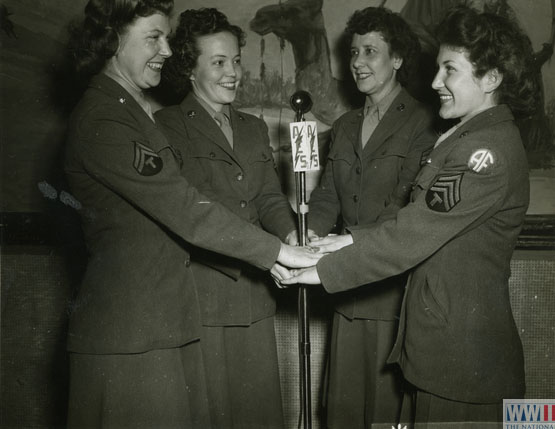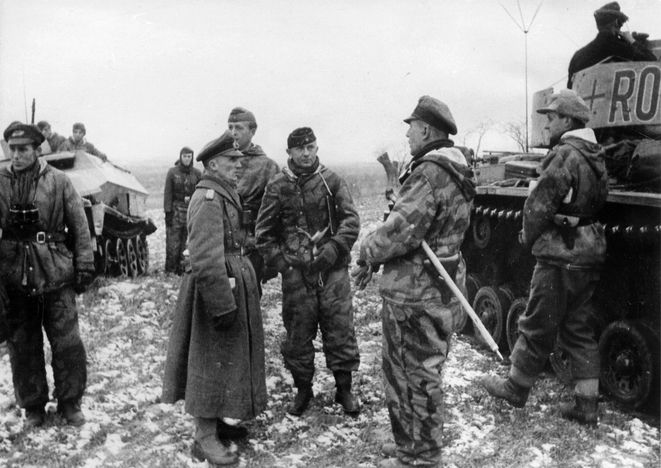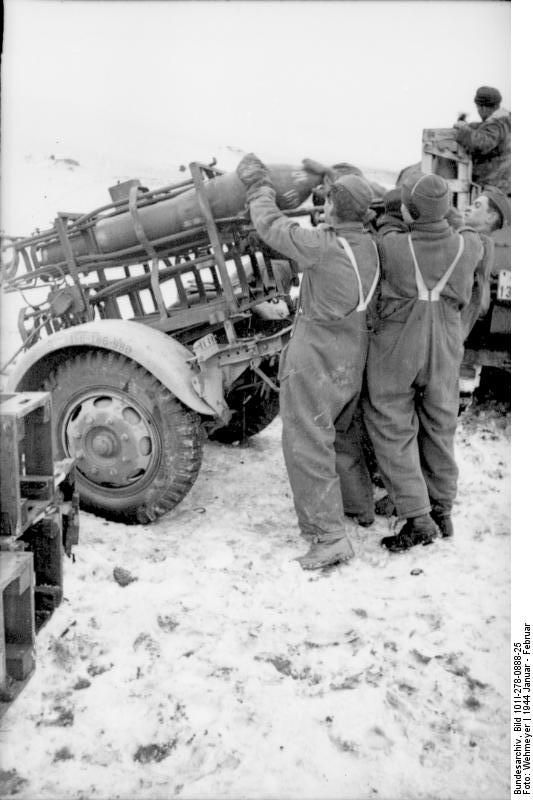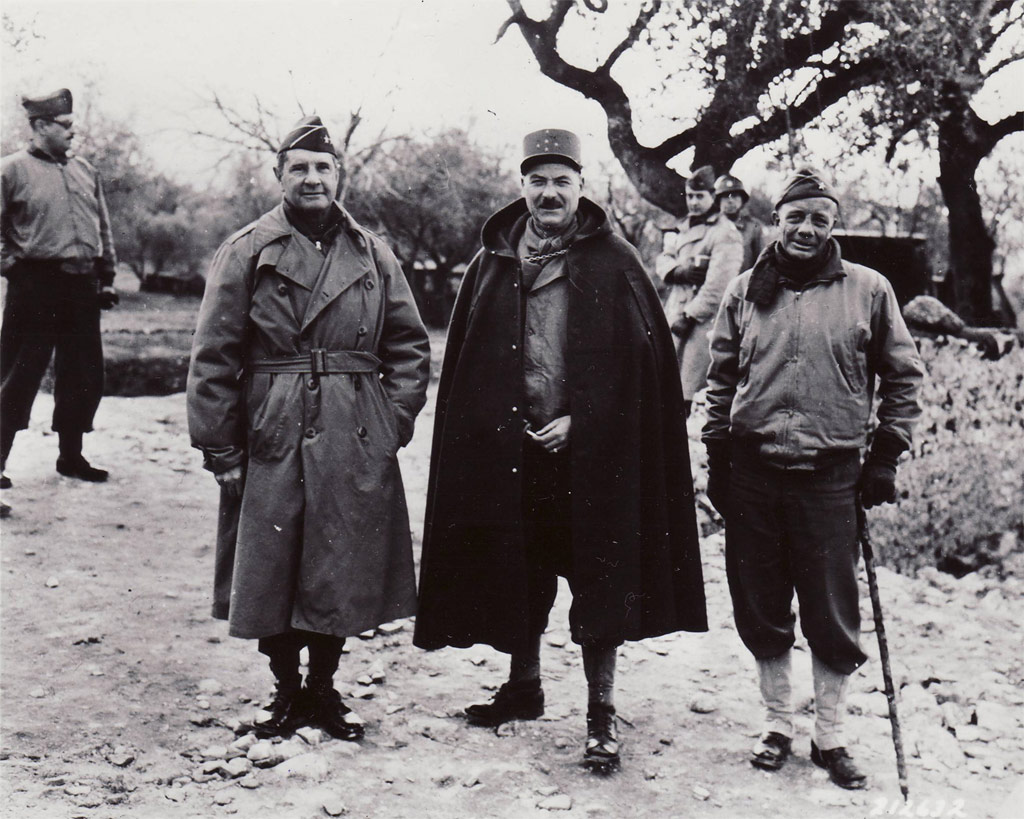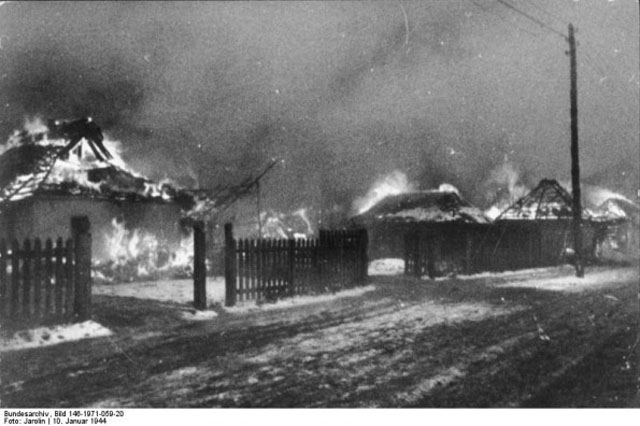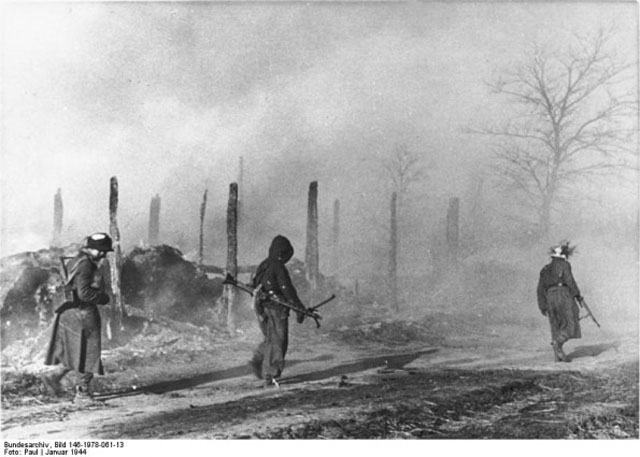Air Operations, Bismarcks
- More than 50 AirSols SBDs, escorted by more than 80 AirSols fighters, attack reventments and antiaircraft batteries at the Lakunai airfield at Rabaul.
- VF-17 F4Us down 8 A6M Zeros over the Rabaul area between 1215 hours. A VF-38 F6F downs an A6M Zero over Simpson Harbor at 1330 hours. VMF-215 F4Us down 14 Zeros, mostly over the Lakunai airfield at Rabaul. 3 AirSols fighters are lost.
- V Bomber Command A-20s attack the Cape Raoult area and V Fighter Command P-40s attack barges along New Britainís northern coast.
Air Operations, CBI
BURMA- 15 7th Heavy Bomb Group B-24s attack Maungdaw. 7 490th Medium Bomb Squadron B-25 and 3 10th Air Force fighters attack a Japanese Army camp at Razabil and nearby targets of opportunity.
- 18 14th Air Force P-40 fighter-bombers attack the airfield at Kengtung and a Japanese Army barracks.
Air Operations, Europe
USAAFCORSICA:
- 414th Night-Fighter Squadron Beaufighters damage and possibly down a Ju-88 and an He-111 while patrolling off Calvi between 1945 and 2015 hours.
FRANCE:
- 144 IX Bomber Command B-26s dispatched to attack V-weapons sites are recalled because of bad weather.
ITALY:
- XII Air Support Command A-20s attack German Army troops defending Cisterna di Latina against a ground attack by the US 5th Army.
- XII Air Support Command fighters and fighter-bombers attack numerous rail, road, and tactical targets in and around the battle area.
- Spitfire pilots of the 31st Fighter Group's 307th Fighter Squadron down 3 Luftwaffe fighters in an engagement over Nettuno, in the Anzio beachhead area, at 1525 hours.
Air Operations, Marshalls
- 9 41st Medium Bomb Group B-25s attack the Maloelap Atoll. When the withdrawing B-25s are attacked over the Aur Atoll by 20 Japanese Naby fighters, P-40s with the 15th Fighter Groupís 45th Fighter Squadron ambush them and down a B5N 'Kate' guide plane and 9 A6M Zeros at 1530 hours. This is the longest over-water combat mission undertaken to date by P-40 fighters, and the first by VII Fighter Command P-40s equipped with belly tanks.
- 9 41st Medium Bomb Group B-25s attack ground targets and shipping in the Jaluit Atoll.
Air Operations, New Guinea
- More than 140 V Bomber Command B-24s and A-20s, and V Fighter Command P-39 fighter-bombers attack targets in the Alexishafen-Madang area and 18 B-25s attack Bogia.
- 41 43rd and 90th Heavy Bomb Group B-24s attack the Momote airfield at Los Negros and nearby dumps in the Admiralty Islands.
Arctic
In further attacks on Murmansk-bound Convoy W-56A U-716 torpedoes and sinks the US freighter Andrew G. Curtin (7200t) losing 2 crewmen and 1 Armed Guard sailor in the attack. 40 of the crew and 27 Armed Guard sailors are rescued by the British destroyer Inconstant.
[CBI
BURMAThe 65th Regiment, Chinese 22nd Division, reaches the Ahawk Stream. The Ahawk Trail along this stream is the shortest route from Taro into the Hukawng valley.
CHINAPres Roosevelt tells Chiang Kai-shek that, while the question of a loan to China is still under discussion, from the beginning of March the United States will limit its monthly supply of aid to a value of 25 million dollars.
[Diplomatic Relations
Liberia declares war on Germany and Japan. Argentina breaks off diplomatic relations with Germany and Japan following the discovery of a vast Axis spy network in the country.
[Eastern Front
Fighting in the northern sector continues from the Gulf of Finland to Lake Ilmen. In the Ukraine the battle of Korsun-Shevchenkosky also rages.
NORTHERN SECTORThe 18th Army is pressed back upon Tosno and Lyuban by the 8th and 54th Armies.
SOUTHERN SECTORThe 27th, 40th and 6th Tank Armies push in the direction of Zvenigorodka, striving to link up with the 5th Guards Tank Army as it advances upon Shpola. The 6th Tank Army has been committed from reserve to strengthen the northern prong of the pincer.
[Indian Ocean
The US freighter Walter Camp (7176t) is torpedoed and sunk by U-532 about 150 miles west of Kochi, India. All on board are rescued by the British light cruiser Danae about 4 days later.
[Italy
Continuing limited attacks toward Cisterna in the US 5th Army's VI Corps area, the 3rd Division reduces a strongpoint near Ponte Rotto. The British 1st Division repels a strong enemy counterattack against the Factory. The British X Corps regroup to renew their offensive. The 46th Division is committed east of Castelforte, shortening the line of the 56th Division. In the II Corps area, advance elements of the 133rd Infantry, 34th Division, reach the edge of Hill 213 against strong opposition but at nightfall fall back to the west bank of the Rapido. At 0330, the 1st Battalion of the 135th Infantry crosses one company over the Rapido just north of Cassino and presses to the edge of town. After daybreak they join elements of the 133rd Infantry in an unsuccessful attack against Point 225, between Cassino and the barracks. The 142nd RCT, 36th Division, is attached to the 34th Division to assist the French in operations to the north. In the FEC area, the 4th Tunisian Infantry, 3rd Algerian Division, seizes Belvedere Hill and Abate Hill. The 3rd Algerian Infantry drives the enemy from Le Propaia.
[Marshall Islands
US B-25 bombers, escorted by fighters for the first time, carry out a raid on Maloelap and destroy a number of Japanese aircraft.
[Mediterranean
Off Anzio, mines sink the US infantry landing craft LCI-32 and damages the tank landing ship LST-422.
[New Britain
More than 200 American fighters and bombers make a particularly heavy attack on Rabaul. Military installations are destroyed and many Japanese planes are shot down and the base is gradually becoming worthless. Since the beginning of the air offensive the US air force is reckoned to have brought down or destroyed on the ground a total of 863 enemy aircraft. At this point the second phase of the battle begins -- the destruction of Rabaul in conditions of complete impunity. For the Japanese base, from the point of view of the air offensive, has ceased to pose any threat to MacArthur's forces in the Solomons and New Guinea.
The US lose PT-110 after a collision with PT-114 off New Britain.
[New Guinea
Elements of the Japanese 18th Army, attempting to by-pass the beachhead at Saidor and reach Madang, come under heavy bombardment from US warships. Troops of the Australian 18th Brigade capture the Kankiryo Saddle, an important Japanese position crossing the western tip of the mountainous Finisterre range. This puts the Australians only 20 miles from the coast.
[Pacific
- The US submarine Skipjack (SS-184) sinks the Japanese destroyer Suzukaze 140 miles northwest of Ponape, Carolines and the transport Okitsu Maru (6666t).
- US naval land-based aircraft sink the Japanese submarine chaser No. 14 in the Central Pacific area.
- The US motor torpedo boat PT-110 is sunk by depth charge explosion following a collision with motor torpedo boat PT-114 in Ablingi Harbor, New Britain.
- The US submarine Crevalle (SS-291) sinks the Japanese gunboat Busho Maru (2552t) in the South China Sea about 175 miles southeast of Capt St. Jacques, French Indochina.
- The US submarine Hake (SS-256) sinks the Japanese auxiliary netlayter Shuko Maru (889t) off Ambon, N.E.I.
Soviet Union, Home Front
The Soviet forensic medical commission on the Katyn Massacre publishes its report. It blames the Germans.
[United States, Planning
Gen Claire Chennault, head of the US Air Force in China, submits to Pres Roosevelt a major plan for air action. First, to gain air supremacy in China, then an offensive against enemy maritime traffic; next attacks against major industrial targets in Japan; finally, offensives against enemy military installations in China, Formosa and Hainan.
[Images from January 26, 1944
|
|
|
|
|
|
Troopers of the 504th Parachute Infantry Regiment |
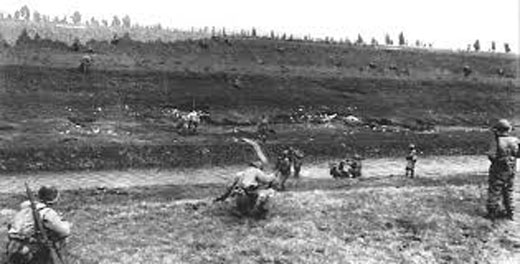 |
